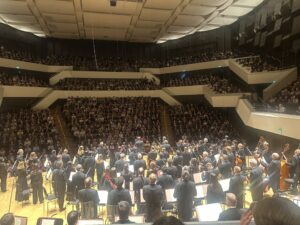This week, I attended a concert at the Gewandhaus Leipzig: an impressive building and performance space that felt just as important to the experience as the music itself. The hall is designed in a way that draws you in: the stage is central, and the audience surrounds it from every side. Our seats were directly in front of the conductor, and we were close enough to read the musicians’ sheet music. That kind of proximity made it easy to feel connected to what was happening on stage, which almost felt like being a part of the music-making process.
The program featured three works:
Johann Sebastian Bach – Concerto for Three Pianos and Orchestra in D minor, BWV 1063
Arthur Honegger – Symphony No. 2 for Strings and Trumpet, H. 153
Johannes Brahms – Symphony No. 4 in E minor, Op. 98
Bach’s concerto opened the evening with an unusual and exciting setup: three grand pianos in a triangular formation. After the performance, one of the pianos was lowered from the stage through what I could only describe as a trap door, which made for a theatrical (and unexpected) moment. Beyond the visuals, the pianists themselves were deeply expressive. It can be hard to physically convey emotion through a seated instrument like the piano, but all three performers found a way to make their interpretations visible through body language and phrasing. It was very engaging and fun to watch.
The Honegger piece stood out for me as the most striking part of the program. The string writing was rich and layered, with a tension that slowly built throughout the piece. From the beginning I felt captivated, like there was something I was waiting for, but I did not want it to end. I didn’t know much about Honegger before this performance, but now I want to learn more. This work was absolutely beautiful.
The final piece, Brahms’ Fourth Symphony, was powerful and beautifully performed. The brass section played with warmth, and the entire orchestra felt very unified. It’s crazy to think that a band and orchestra, two very different sounds, can come together into such a harmonious body. It’s easy to hear why this work is so well-known—its balance of complexity and emotion is something I’ve come to appreciate more the deeper I get into performance and analysis.
Overall, this concert reminded me how much more I notice in live performances now than I used to. Being a musician and leaning more into my ear for music when attending a performance has changed the way I listen. There’s more awareness of detail, effort, and nuance. Watching professionals perform at such a high level was both inspiring and motivating, and it’s definitely a night I’ll remember.
